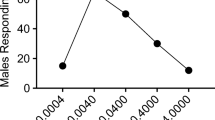Abstract
Confuser® V is a pheromone-based mating disruptant designed to reduce damage caused by seven species of moth pests, including the beet semilooper, Autographa nigrisigna (Lepidoptera: Noctuidae). Eggs and larvae of A. nigrisigna are often found in fields treated with Confuser® V, suggesting that some components in the Confuser® V blend may have adverse effects on the efficacy of mating disruption of this species. Therefore, we examined whether A. nigrisigna perceives heterospecific pheromone components in the Confuser® V blend and delineated the roles of these components with respect to attraction and communication disruption. We found that several heterospecific pheromone components in the Confuser® V blend were perceived by male A. nigrisigna, and the addition of these components to the pheromone blend of A. nigrisigna reduced the attraction of males in the field, and tended to reduce the efficacy of mating disruption in cage bioassays.


Similar content being viewed by others
References
Allison JD, Cardé RT (2016) Pheromones: reproductive isolation and evolution in moths. In: Allison JD, Cardé RT (eds) Pheromone communication in moths. University of California Press, Oakland, pp 11–23
Bengtsson M, Karg G, Kirsch PA, Löfqvist J, Sauer A, Witzgall P (1994) Mating disruption of pea moth Cydia nigricana F. (Lepidoptera: Tortricidae) by a repellent blend of sex pheromone and attraction inhibitors. J Chem Ecol 20:871–887
Borden JH (1997) Disruption of semiochemical-mediated aggregation in bark beetles. In: Cardé RT, Minks AK (eds) Insect pheromone research -new directions. Springer, Dordrecht, pp 421–438
Cardé RT, Haynes KF (2004) Structure of the pheromone communication channel in moths. In: Cardé RT, Millar JG (eds) Advances in insect chemical ecology. Cambridge University Press, Cambridge, pp 283–332
Eizaguirre M, Sans A, López C, Albajes R (2002) Effects of mating disruption against Mediterranean corn borer, Sesamia nonagrioides, on the European corn borer,Ostrinia nubulalis. IOBC WPRS Bull 25:59–68
Evenden M (2016) Mating disruption of moth pests in integrated pest management-a mechanistic approach. In: Allison JD, Cardé RT (eds) Pheromone communication in moths. University of California Press, Oakland, pp 365–393
Gemeno C, Sans A, López C, Albajes R, Eizaguirre M (2006) Pheromone antagonism in the European corn borer moth Ostrinia nubilalis. J Chem Ecol 32:1071–1084
Hashiyama A, Nomura M, Kurihara J, Toyoshima G (2011) Application of molecular techniques to the identification of three plusiine species, Autographa nigrisigna, Macdunnoughia confusa, and Thysanoplusia intermixta (Lepidoptera: Noctuidae) found in IPM lettuce fields in Japan. J Econ Entomol 104:1280–1285
Hashiyama A, Nomura M, Kurihara J, Toyoshima G (2012) Field density and species structure of plusiine moths found in the pheromone treated lettuce fields. HortResearch 66:11–16 (in Japanese)
Hashiyama A, Nomura M, Kurihara J, Toyoshima G (2013) Laboratory evaluation of the flight ability of female Autographa nigrisigna (Lepidoptera: Noctuidae), measured by actograph and flight mill. J Econ Entomol 106:690–694
Kawasaki K, Ikeuchi M, Hidaka T (1987) Laboratory rearing method for Acanthoplusia agnata (Lepidoptera: Noctuidae) without change of artificial diet. Jpn Appl Entomol Zool 31:78–80 (in Japanese)
Leal WS (1996) Chemical communication in scarab beetles: reciprocal behavioral agonist-antagonist activities of chiral pheromones. Proc Natl Acad Sci U S A 93:12112–12115
Löfstedt C, Wahlberg N, Millar JG (2016) Evolutionary patterns of pheromone diversity in Lepidoptera. In: Allison JD, Cardé RT (eds) Pheromone communication in moths. University of California Press, Oakland, pp 43–78
Ministry of Agriculture, Forestry and Fisheries of Japan (2021) Information service system of registered agricultural chemicals. https://pesticide.maff.go.jp/agricultural-chemicals/details/23084. Accessed 2 July 2021 (in Japanese)
Mustaparta H (1997) Olfactory coding mechanisms for pheromone and interspecific signal information in related species of moths. In: Cardé RT, Minks AK (eds) Insect pheromone research -new directions. Springer, Dordrecht, pp 144–163
R Core Team (2020) R: A language and environment for statistical computing. R Foundation for Statistical Computing, Vienna, Austria. https://www.R-project.org/. Accessed 2 July 2021
Suckling DM, Gibb AR, Daly JM, Rogers DJ, Walker GP (2002) Improving the pheromone lure for diamondback moth. NZ Plant Prot 55:182–187
Sugie H, Kawasaki K, Nakagaki S, Iwata N (1991) Identification of sex pheromone of the semi-looper Autographa nigrisigna. Apple Entomol Zool 26:71–76
Sun F, Hu YY, Du JW (2002) The sex pheromone communication system of Spodoptera litura (Fabricius). Acta Entomol Sin 45:404–407 (in Chinese)
Tamaki Y, Osawa T, Yushima T, Noguchi H (1976) Sex pheromone and related compounds secreted by the virgin females of Spodoptera litura (F.). Jpn J Appl Entomol Zool 20:81–86 (in Japanese)
Wyatt TD (2014) Pheromones and Animal Behavior, 2nd ed., Cambridge University Press, pp 405
Yang CY, Lee S, Choi KS, Jeon HY, Boo KS (2007) Sex pheromone production and response in Korean populations of the diamondback moth, Plutella xylostella. Entomol Exp Appl 124:293–298
Zhu J, Chastain BB, Spohn BG, Haynes KF (1997) Assortative mating in two pheromone strains of the cabbage looper moth, Trichoplusia ni. J Insect Behav 10:805–817
Acknowledgments
We appreciate Dr. Jocelyn G. Millar of the University of California, Riverside reviewing the manuscript, and Shin-Etsu Chemical Co., Ltd. providing us with the chemicals that we used in the study.
Author information
Authors and Affiliations
Corresponding author
Rights and permissions
About this article
Cite this article
Igarashi-Hashiyama, A., Nomura, M., Hayashi, M. et al. Perception of Heterospecific Sex Pheromone Causes Less Effective Mating Disruption in the Beet Semilooper, Autographa nigrisigna (Lepidoptera: Noctuidae). J Chem Ecol 48, 1–6 (2022). https://doi.org/10.1007/s10886-021-01322-6
Received:
Revised:
Accepted:
Published:
Issue Date:
DOI: https://doi.org/10.1007/s10886-021-01322-6




